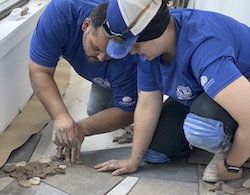A family effort brings solace to the Children’s Bereavement Center of South Texas


As a contractor you can be considered lucky to be tasked with a truly unique project that touches you personally and challenges you professionally, both technically and creatively. The Children’s Bereavement Center of South Texas is a non-profit organization that focuses on changing lives by helping grieving children and families heal after the death of a loved one. In the remodel of their San Antonio location, they reached out to create an inspirational 76′ long, 54″ wide hallway with two 60 sq. ft. rectangular landings at each end for the main entrance of their building. The goal was to depict a beautiful mosaic woodland pathway to create a sense of wonder and beauty, and reflect the emotional journey of healing for each family. My wife Lori, my son Cody, members of the Cox Tile team and I all have people close to us who have benefitted from the Center’s amazing services.


The pathway begins with small pieces of broken tiles, symbolizing the fragility of the children entering the program and gradually progresses to larger, stronger pieces as the path continues, representing the healing process. Along the sides of the path, mosaic murals incorporate flora and fauna to tie in with the full wall painted mural. Butterflies were requested, since that is the program logo.
Working in a tight, heavily-trafficked area (the Center was still fully operational) with an undulating substrate proved to be highly difficult, spurring much “thinking outside the box.” For the path, each 24″x48″ piece of porcelain field tile was cut multiple times with a water saw and then pieced randomly together, mixing colors, sizes and shapes. We used Karl Dahm, Gemini Revolution XT, Lasertech 5000 and 7000 and Diamond Elite water band saws, resulting in over 1,000 pieces of field tile meticulously pieced together for the path. High spots in the substrate were ground down with Milwaukee hand grinders, low spots augmented for a flat installation.
The mosaic border: a family project
The path border followed a colored map with flowing, patterned designs. We needed to use thousands of 1″x1″ and 1″x2″ individual glass mosaic tiles in bags of 14 different colors and finishes to form this mosaic border.


Schematics and some of the thousands of glass tiles used to create the mosaic borders. 

Portion of the schematic layout of the project.


Patterns were custom created by setting the glass mosaic designs individually, offsite, piece by piece. Plans were enlarged to life size, and the entire floor was double-templated to have templates on the jobsite and templates offsite at the shop where the panels were created. The glass mosaic tiles were cut with the water band saws and hand placed to fit the desired flowing multi-directional color patterns. Using clear Tile Tape, the designs were then transferred, set with Custom Building Products’ Prolite thinset and grouted on a 1/8″ Profile cement board in small sections, to make them stable to transport, trim and then piece together like a giant puzzle.


This became a family project, since “all hands on deck” were needed to create and build the custom butterflies, dragonflies, bumblebees, geckos, turtles and many different types of flowers needed for the installation. Most of the creatures and flowers were created by my wife, Lori, with a variety of thicknesses of glass and tile that she cut and set piece by piece using a band saw and Glastar Glass Grinder to maintain flatness on cement board. These pieces were then grouted and individually scribed and set by our CTEF Certified Tile Installers into the mosaic panels and field tile. Every piece of mosaic glass cut had to have edges ground for safety with the glass grinder and tabletop belt sanders.
Glass mosaics, porcelain field tile, stained glass and miscellaneous ceramic tiles were used to create the 147 flower, insect and creature inserts. All materials were different types and thicknesses so great care was used to ensure a smooth and flat finished floor. The pebbles and inserts were then scroll cut into the glass mosaic panels and field tile pathway. Even with the templates, additional onsite scrolling by the multi-talented Cox Tile team was performed for the mosaic panels to be installed to meet the pathway exactly. Then the custom inserts were added into the precut scrolled areas. Litokol Starlike Crystal EVO epoxy grout was used on all the glass tile to provide structure and also to reflect the various colors of the glass tiles. MAPEI CQ Flexcolor urethane grout was used on the field tile.


In the entryway, the butterflies cut from solid glass in muted blues morph into full color as they enter the path and are joined by various flowers and other creatures. Giving children the needed distraction of discovering different wildlife along the path was paramount, as they enter the center bewildered and traumatized. Countless hours of tedious and meticulous time-consuming work over a six-week period allowed us to proudly present this elaborate puzzle embracing the fragility of life and the path to recovery. The project was completed with love and compassion by the entire Cox Tile family for every person that enters and exits that building. Supporting their mission was such an honor and gourmet food for the soul.


John Cox
John Cox is the owner and president of Cox Tile, Inc., of San Antonio, Texas. Cox is a lifetime Texas resident and has been in the tile industry since 1975. He launched Cox Tile in 1981 as a full-service, high-quality tile contracting company, and personally oversees all projects and work crews to ensure the quality of workmanship and complete customer satisfaction.









